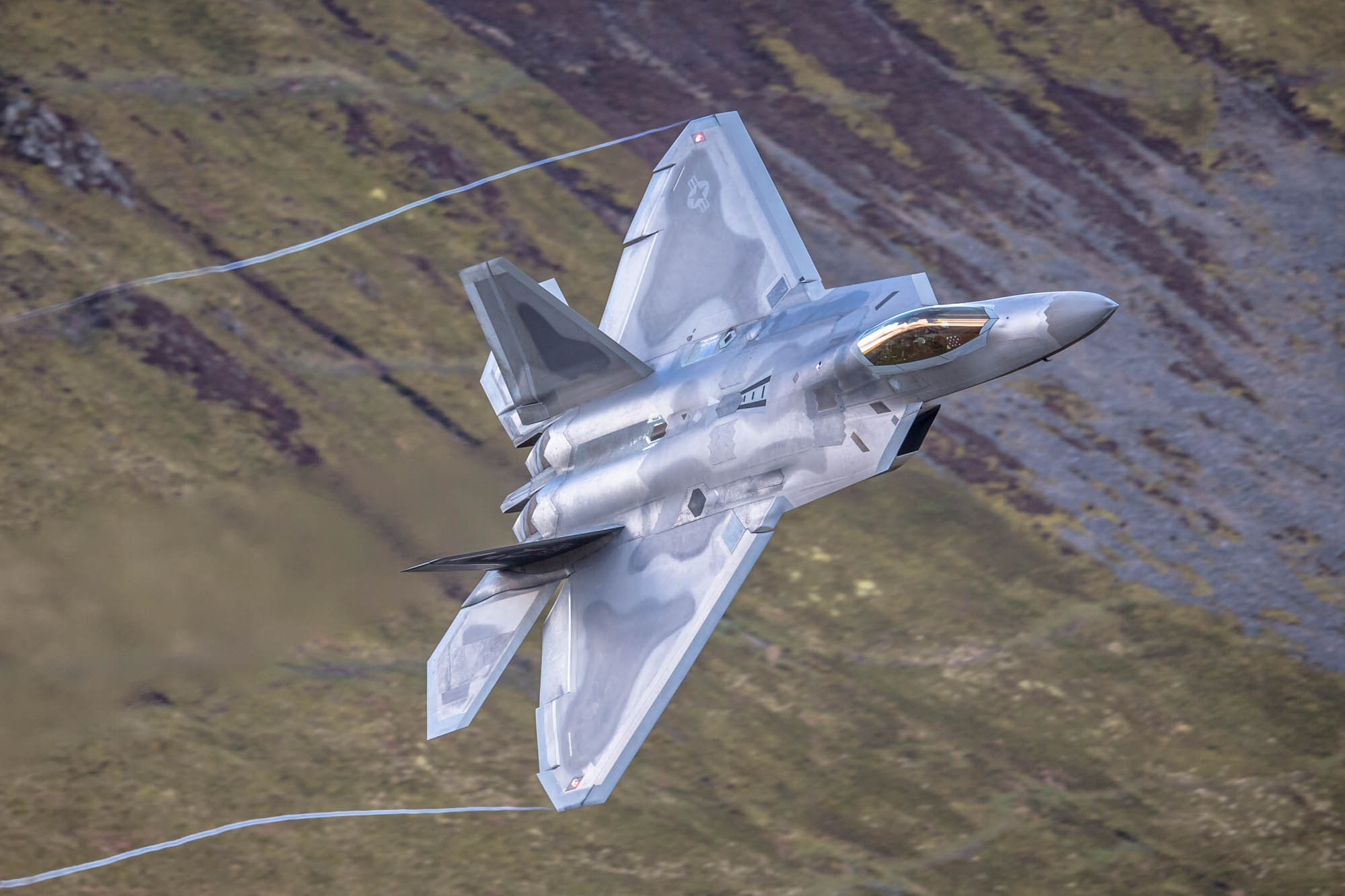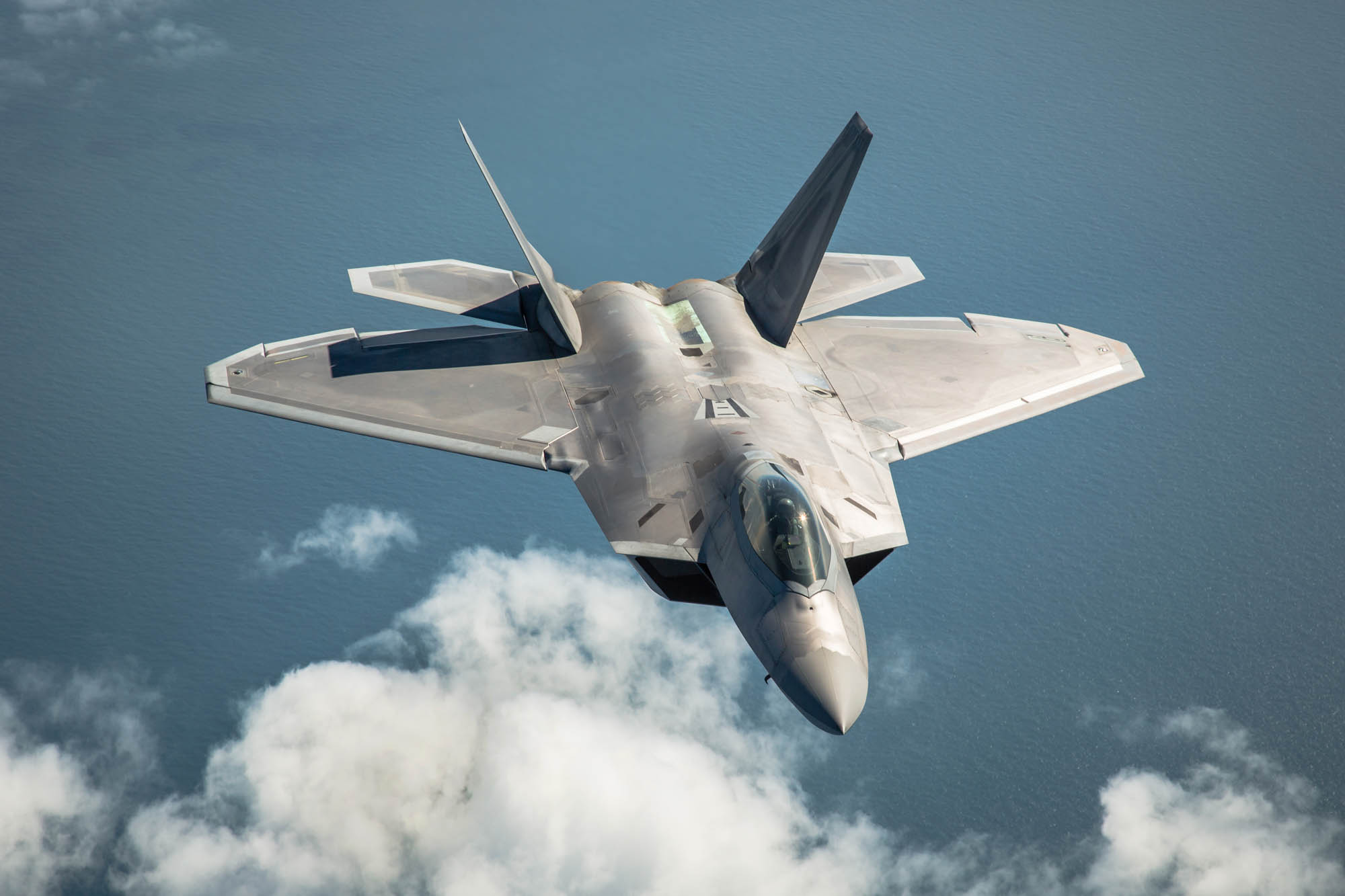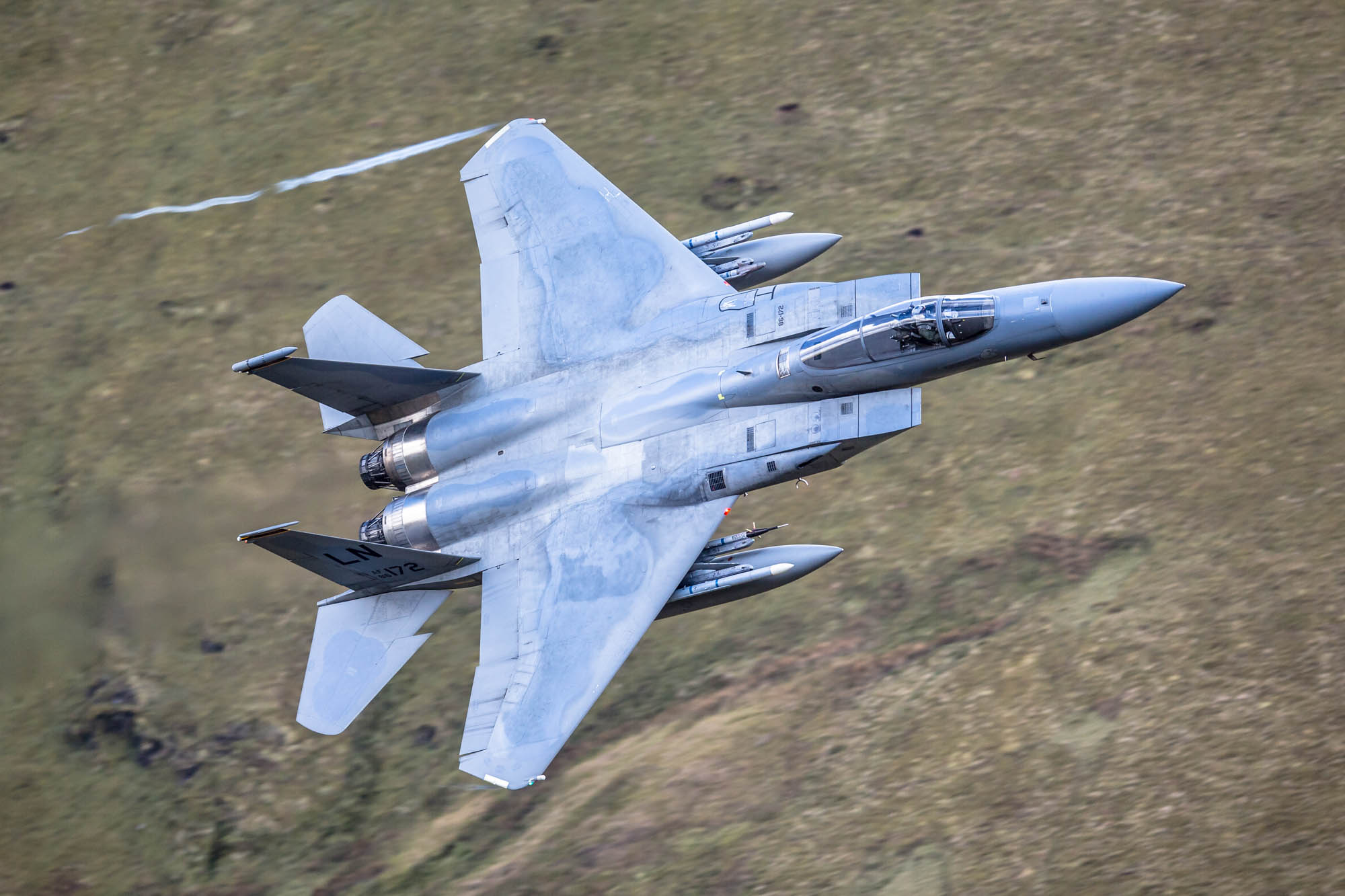Low-level Photography
Exercise Iron Hand 16-3 / Rapid Raptor
April-May 2016
|
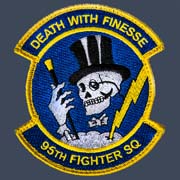
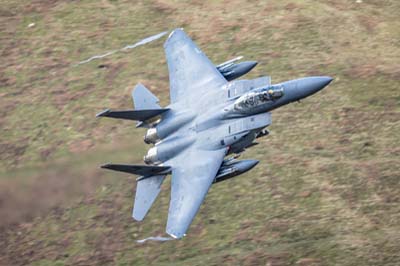 |
The 494th FS flight leader of the famed mixed formation was flying an F-15E Strike Eagle using callsign 'Rage 21'. |
95 Fighter Squadron's 'Rapid Raptor' deployment to Europe
For many the Lockheed-Martin/Boeing F-22A Raptor has slipped from the front page since it became fully operational in 2005, this is not surprising with the attention the Lockheed-Martin/Boeing F-35A/B/C Lightning II has been given with its cost over-runs and long development phase.
The USAFs 95th Fighter Squadron (FS) has done everything it can to put the fifth generation multi-role Raptor back in to the news, with a four week deployment to RAF Lakenheath in Suffolk, United Kingdom which ended on May 6th. RAF Lakenheath is the home of the 48th Fighter Wing (FW) which is assigned Boeing F-15E Strike Eagles from the 492nd and 494thFS and F-15C Eagles from the 493rdFS.
Twelve F-22A Raptors arrived in three flights of four without prior announcement as a capability demonstration of the Global Response Force (GRF) which can be tasked by the U.S. Secretary of Defense to respond to crisis situations known as 'Rapid Raptor'. The GRF provides an array of tailorable and rapidly deployable forces which can respond quickly to a range of worldwide contingencies. This F-22 deployment was designed to test the GRF capability and the Rapid Raptor concept to quickly deploy America's only combat proven 5th generation fighter on a moment's notice anywhere in the world. Following the nine hour transit across the Atlantic and twelve air to air refuelling (AAR) operations the clean F-22s arrived at RAF Lakenheath. Just a few hours later the jets were flying sorties with the F-15Es further demonstrating the capability of the Rapid Raptor concept. |
Largest F-22 deployment to Europe
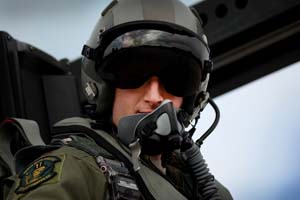 |
For 95FS assistant director of operations Major Michael “Deep” Frye and F-22 instructor pilot RAF Lakenheath is very familiar as he was previously based here flying the F-15C Eagle with the 493 FS from 2008 to 2011 before converting to the F-22 in 2012. Photo credit 48FW. |
With twelve F-22s and 220 airmen this was the largest F-22 deployment to Europe to date. Exercise Iron Hand 16-3 encompassed most of the missions flown. These missions consisted of flying against multiple advanced air-to-air and surface-to-air threats and included F-22s dropping simulated ordnance.
The training did not only involve aircraft from the 48FW but also assets of the Royal Air Force with sorties flown with and against Eurofighter Typhoons based at RAF Coningsby and air to ground attacks on RAF Spadeadam situated in northern England and Europe's first electronic warfare tactics range. Here aircrews can practise manoeuvres and tactics against a variety of sophisticated threats and targets that they could face in contemporary warfare.
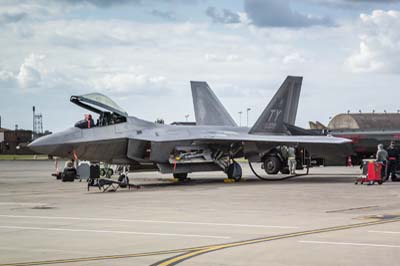 |
The F-22A Raptor combines stealth, super cruise, agility, situational awarenessand integrated avionics, coupled with improved supportability, it can perform both air-to-air and air-to-ground missions. For air-to-air the Raptor carries six AIM-120 AMRAAMs and two AIM-9 Sidewinders in closed weapons bays so not to impact on its stealthy characteristics. For air-to-ground operations it will typically carry two 1,000 pound GBU-32 Joint Direct Attack Munitions (JDAM) internally and also carry two AIM-120s and two AIM-9s. |
Most days were marked by early departures of between two and eight Raptors intermingled with mass launches of the Lakenheath based 48th Fighter Wing's Boeing F-15E Strike Eagles from the 492nd and 494thFS and F-15C Eagles from the 493rdFS. Waves of departures continued in to the afternoon and early evening. Some of the planned 16 sorties per day lasted just 30 minutes others would last around two hours and would include AAR provided by Boeing KC-135R Stratotankers from the 100ARW based at nearby RAF Mildenhall.
The 48FW's pilots benefitted greatly from the missions flown with the 95FS, as the sorties were varied the missions could be described as standard says 95FS assistant director of operations Major Michael "Deep" Frye and F-22 instructor pilot. Each mission played to each fighter's strengths while avoiding potential weaknesses. Maj Frye however was able to describe an example of an Offensive Counter-Air focused training mission; "The F-15Cs integrated with F-22s to gain air dominance against an advanced air-to-air fighter threat, allowing the F-15Es to roam freely across the battlespace and further integrate with F-22s to find, fix, target, track, engage and assess both medium and long-range Surface-to-Air Missile (SAM) sites in a contested Integrated Air Defense System (IADS) environment".
Flying at low-level
The 95FS utilised as much of UK airspace as they could, but it was not expected that the F-22 would fly any low-level missions, after all the F-22 is a stealthy air superiority fighter and should not need to evade enemy radar by flying at low-level.
On April 26, 2016 'Rage 21' was heard calling passing through the Lichfield Corridor in the direction of Wales, so my hopes were raised that I would be getting some F-15Es through the Loop. The day was a little dull so I had elected to go to the Spur which is a south facing hill. What came next on the scanner from 'Rage 21' was total surprise, "Rage 21 flight, we are a mixed formation of two fox one five echos, two fox twenty twos and one fox one five charlie entering Low Fly Area 7 over Bala Lake north to south for 20 minutes, 500 feet, 500 knots." Wow, no one had expected the Raptors to go low-level during their deployment!
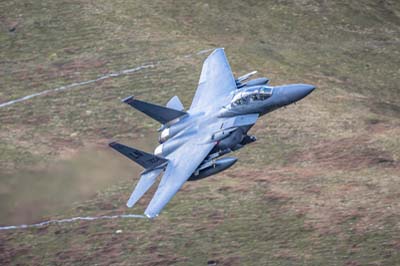 |
F-15E Strike Eagle (00-3004 'LN') 'Rage 22' of 494FS was the last low pass in the mixed formation. |
It transpired that Captain Mathew 'Gate' McQueeney with the 494th FS, was 'Rage 21' and flight leader, Maj "Deep" Frye was flying the lead F-22 as 'Mongol 21'. Maj Frye the lead F-22 pilot described this mission flying at 450 knots ground speed, "Flying the Mach' Loop was a unique opportunity to hone our low-level proficiency in mountainous terrain, which is something we don't have the capability to train to at our home station in Florida.
Col Novotny appreciates the low flying training value provided by the United Kingdom Low fly System (UKLFS), "Sending the Raptors into Low Fly Area 7 was an opportunity for their low-altitude qualified pilots to see first-hand, the amazing training opportunities we have in the United Kingdom. The training ranges and low flying airspace here are some of the best in the world."
Many pilots in the 95FS have previous experience operating on the ranges in the Western U.S. and Alaska, which are quite similar to the ranges in Wales." Maj Frye continued, "Flying a Raptor through the Mach' Loop [training area within LFA7] is no different than any other fast jet in the low-level arena, it requires significant mission planning and a spot-on crosscheck to mitigate the inherent risks of tactical manoeuvring close to the ground." In summary "This low-level mission provided us the unique opportunity to practice tactical manoeuvring within the low altitude structure. This training flight highlighted the differences required in intercept geometry, the increased performance of the F-22, the uniqueness of low-level mission planningand most importantly, the risks associated with low-level flying".
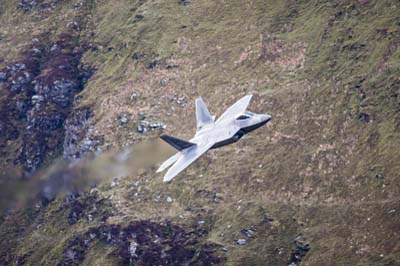 |
Just passing 'Bluebell' hill and closing in fast was F-22A Raptor (05-081 'TY') of 'Mongol Flight' of 95th FS, 325th FW from Tyndall Air Force Base. |
For the F-22 pilots involved a higher level of mission planning was required to fly this low-level sortie in mid-Wales due to their unfamiliarity with the terrain, the weather and the procedures required by the UKLFS. It began with a thorough review of UKLFS procedures to include route abort procedures, bird avoidanceand on route weather considerations. The bulk of the mission planning day was spent building the low fly route, map construction to include NOTAMS and bird and noise avoidance areasand fuel planning. The mission brief involved all participants and covered the entirety of mission in significant detail, including a computer generated 'live fly' of the route and a hefty discussion on contingencies. 48FW pilots are very familiar with flying at low-level within the UKLFS as they do it on a daily basis and so were able to offer much valued advice, which was greatly appreciated by the F-22 pilots, "As a result of the mission planning process and leveraging of the experience of our local experts [48FW pilots], the execution of the mission went off without a hitch", said Maj Frye.
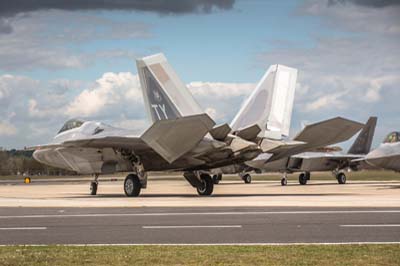 |
Supercruise increases the jet’s speed and range over current fighters use fuel-consuming afterburner to operate at supersonic speeds. The F-22’s Pratt and Whitney F119-PW-100 turbofan engines with afterburners produce more thrust than any other current fighter engine and includes two-dimensional thrust vectoring nozzles. |
"Testing our interoperability"
Maj Frye also spoke of their missions with the RAF's Typhoons and Panavia Tornado GR.4s; "Having just successfully completed Exercise Red Flag at Nellis Air Force Base in Nevada by integrating with RAF Typhoons, we looked forward to again testing our interoperability and mission planning processes. We flew a variety of Offensive and Defensive Counter-Air missions with the Typhoons and GR4 Tornados, relying on them in differing capacities as dictated by the tactical scenario. Each time we test our current tactics, training and procedures (TTPs) we walk away with newer and better lessons learned that only serve to increase our joint lethality in future engagements".
Lessons learned
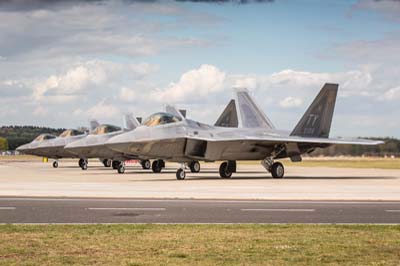 |
Low-observable or stealth technologies utilising radar absorbent materials (RAM) enables the Raptor to pass undetected by radar through enemy airspace. In a previous deployment it was reported that F-22s over Syria flew at 60,000 feet apparently undetected by forces on the ground and in the air below them. |
Maj Frye described the lessons learned during the deployment; "While flying the F-22 is no different here than anywhere else in the world, the uniqueness of fighter integration with our NATO allies is what provides the greatest training value", adding "The crosstalk that happens across multi-national MDS's (Mission Designation Series) throughout the brief, executionand debrief provides the bulk of the lessons learned which are invaluable to our future coalition operations".
The F-22s were not confined to the UK during the deployment, as a further demonstration of the commitment to NATO and to maximise training opportunities a pair of F-22s forward deployed from the UK to their NATO partners in Romania and Lithuania each pair supported by a 100ARW KC-135R air refuelling tanker. Additionally on April 20 along with two Boeing B-52H Stratofortress flying directly from their home base of Minot AFB North Dakota, four F-22s participated in a flypast to commemorate the 100th Anniversary of the Lafayette Escadrille in Paris, France.
The Raptor pilots of the 95FS clearly succeeded in demonstrating 'Rapid Raptor' deployment to Europe with the largest Raptor force so far to ultimately challenge the skills of airmen flying less sophisticated aircraft to the best of their ability. |
